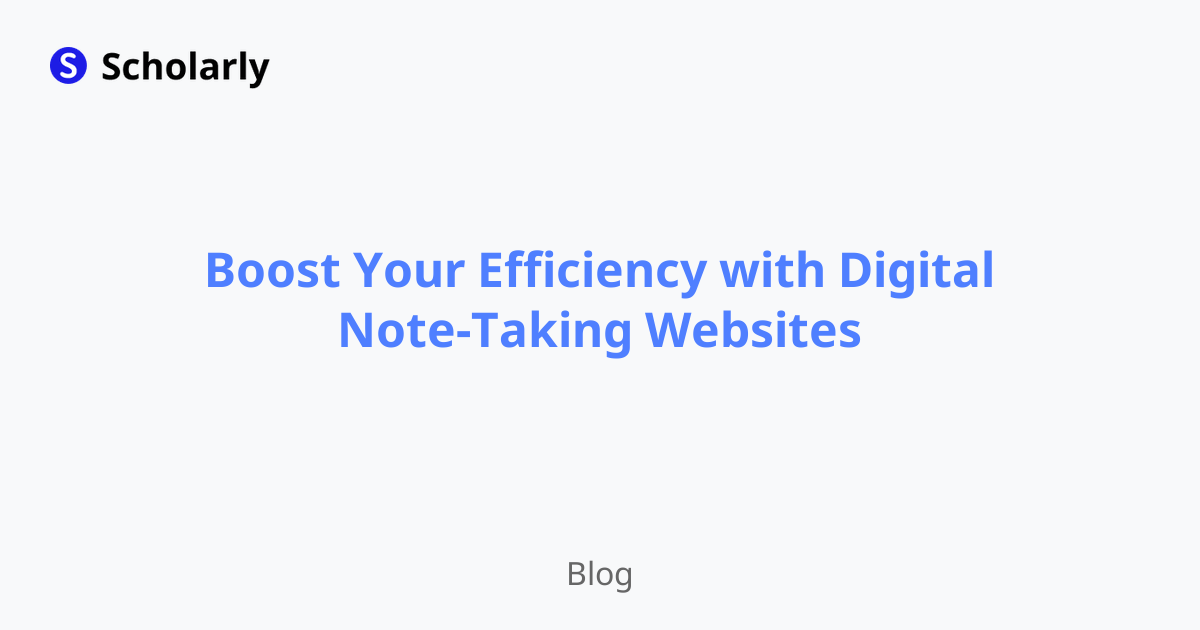Boost Your Efficiency with Digital Note-Taking Websites
Discover how digital note-taking websites can revolutionize the way you manage information, study, and work. Explore the history, benefits, methods, and potential of digital note-taking that includes AI-powered features. Learn about the significance of adopting this practice for efficiency, compare different tools, and get insights into the future of note-taking with AI. This comprehensive guide covers best practices, pros and cons, common techniques, and challenges to help you maximize your productivity. Also find out how Scholarly, with its AI-generated text completion and flashcard creation, fits into the evolving landscape of digital note-taking tools.

In our information-rich and fast-paced world, the ability to manage knowledge effectively is more crucial than ever. Digital note-taking websites have emerged as powerful allies in this endeavor, helping individuals across various domains boost their efficiency and streamline their workflows. With the advent of artificial intelligence (AI), these tools have transformed from simple digital paper to dynamic environments that assist in organizing, recalling, and utilizing information at unprecedented levels.
Introduction
Understanding the shift from traditional pen and paper to digital note-taking platforms is essential. In this article, we will explore the evolution, current state, and future of digital note-taking, including the role of AI in this domain. We'll also examine the myriad benefits and potential challenges that come with adopting these digital solutions, compare the leading tools in the market, and delve into the best practices for optimizing note-taking habits. Additionally, we will shed light on popular techniques, methods, and upcoming features that may soon become standard in digital note-taking websites.
The introduction will set the stage for a detailed exploration of topics such as past and current tools for note-taking, best practices, significance, AI impact, and the future outlook for digital note-taking solutions. Notably, we will highlight Scholarly, an innovative tool that leverages AI to enhance the learning and note-taking process. Features like AI-generated text completion, flashcard creation, and transcribing capabilities make Scholarly a standout platform that you can sign up for at **Scholarly Signup**.
History
Past State
Our journey with note-taking starts with rudimentary methods — from carving into stone tablets to scribbling on papyrus. With the invention of paper and ink, note-taking became more accessible, spurring a revolution in knowledge dissemination. The dawn of the digital age brought a significant leap forward, transitioning from physical notebooks to computer-based tools like Microsoft Word and later, specialized note-taking applications.
Current State
Today, note-taking has embraced digital transformation with websites and apps like Evernote, OneNote, and Notion, which offer synchronized, cloud-based platforms accessible on multiple devices. Scholarly, with its suite of AI-powered features, represents the cutting edge of this evolution.
Future State
Looking forward, AI will play an ever-increasing role in note-taking. We can anticipate tools that not only store information but actively help summarize, analyze, and connect data points, significantly expanding the capabilities of digital note-taking platforms.
Benefits
Digital note-taking websites offer numerous advantages. Here are a few key benefits:
Accessibility
Organization
Integration
Collaboration
Enhanced Learning
Each benefit has a profound impact on the user experience, from instant access to notes across devices to improved cognitive processes.
Significance
The significance of digital note-taking lies in its potential to transform how we learn, work, and communicate. The convenience of having all your notes in one place, easily searchable and shareable, represents a significant improvement over traditional methods.
Best Practices
Adopting best practices in digital note-taking is crucial for getting the most out of these platforms. Here are five key practices:
Consistent Formatting
Regular Reviews
Effective Tagging
Strategic Structuring
Interactive Elements
Pros and Cons
Digital note-taking has its set of advantages and disadvantages. Pros include real-time synchronization and cloud storage, while cons might be over-reliance on technology and potential privacy concerns.
Comparison
In our comparison of tools, we include Scholarly's innovative AI features. Other platforms also offer unique functionalities, and users should consider their specific needs when selecting a note-taking service.
Methods
Several methods can be employed to improve digital note-taking, such as the Cornell Method or the Mapping Method. Understanding and utilizing these strategies can lead to more efficient note organization and retrieval.
AI Impact
AI's impact on note-taking is profound, offering possibilities such as automated summarization and personalized review sessions. Scholarly sits at the forefront of this AI integration, transforming the way users interact with their notes.
Common Techniques
Effective note-taking is not just about the tool but also about the techniques applied. Methods like the Five Rs of Note-Taking (Record, Reduce, Recite, Reflect, and Review) remain relevant in the digital age.
Challenges
While digital note-taking websites bring many advancements, they also pose challenges such as information overload and distraction. It's important to use these tools mindfully to avoid such issues.
Potential Online Apps
Numerous apps cater to different styles and needs of note-taking, such as Scholarly, which integrates AI to transform the user experience further.
Conclusion
In conclusion, embracing digital note-taking websites, especially those fortified with AI like Scholarly, can significantly enhance productivity and learning. Our comprehensive discussion covered history, benefits, significance, best practices, pros and cons, comparison, AI impact, common techniques, challenges, and potential online apps, all contributing to the understanding of digital note-taking's pivotal role in today's world.
Try Our Popular AI Study Tools
Transform your study materials into interactive learning experiences with our most popular AI-powered tools:
PDF to Flashcards
Convert lecture notes and textbooks into study flashcards instantly
Text to Flashcards
Turn any text or notes into comprehensive flashcard sets
Image to Flashcards
Convert diagrams and handwritten notes into digital flashcards
YouTube to Flashcards
Generate flashcards from educational video content



